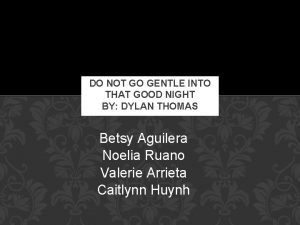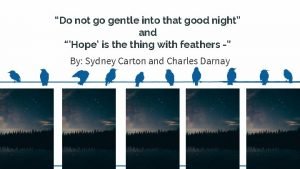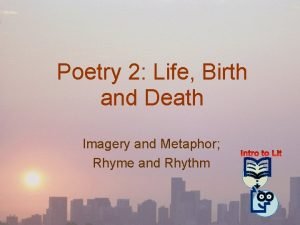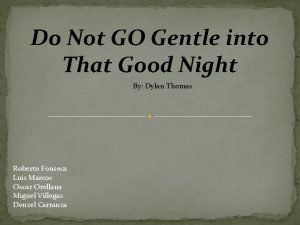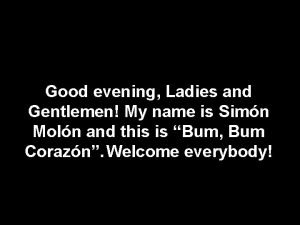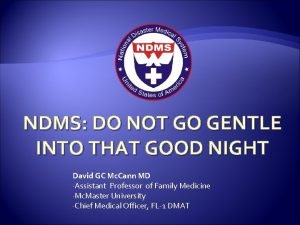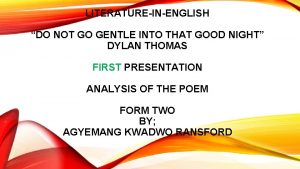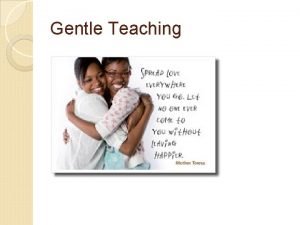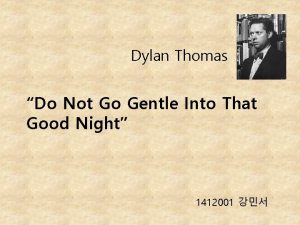Do Not Go Gentle Into That Good Night

















- Slides: 17

Do Not Go Gentle Into That Good Night

Look at the images on the following page: • Consider what each of the images says to you; • If they are related to the poem, what do you think it is about? • Make some notes for each of the images and then discuss with your partner.


Task 2 • Sequence the poem into what you think is the correct order. • In pairs discuss your choices.

Use the clues below to help you arrange the poem into the correct order: • The poem has six stanzas, five of which are of three lines each. • The poem ends with a rhyming couplet. • There are only two different rhymes in the poem. • The first and third lines of the first stanza are repeated alternately as the last line of the remaining stanzas. • The stanza with four lines is the final stanza. • Look for patterns of words or ideas.

Do Not Go Gentle into that Good Night Task 3 • https: //www. youtube. com/watch? v=zb. Hjy. MJs Cq. A • Watch the video and consider how their first impressions differ.

Task 4 Look at the poem as a whole: Complete the diamond nine grid putting what you feel are the most striking lines or images in order of importance 1 -9. Do Not Go Gentle Into That Good Night Do not go gentle into that good night, Old age should burn and rave at close of day; Rage, rage against the dying of the light. Though wise men at their end know dark is right, Because their words had forked no lightning they Do not go gentle into that good night. Good men, the last wave by, crying how bright Their frail deeds might have danced in a green bay, Rage, rage against the dying of the light. Wild men who caught and sang the sun in flight, And learn, too late, they grieved it on its way, Do not go gentle into that good night. Grave men, near death, who see with blinding sight Blind eyes could blaze like meteors and be gay, Rage, rage against the dying of the light. And you, my father, there on that sad height, Curse, bless, me now with your fierce tears, I pray. Do not go gentle into that good night. Rage, rage against the dying of the light.

Emotions Task 5 • The poem is often viewed as one which shows real emotions and one that expresses feelings that many experience. • Task: Plot your emotional response to the poem as you read through each stanza. (1= least emotions and 10= strongest emotions)

Stanza 1 Do not go gentle into that good night, Old age should burn and rave at close of day; Rage, rage against the dying of the It is clearlight. from this stanza that Thomas sees life as a day – death is presented as the closing of that day, and the dying of the light is the sunset and coming night. Look at the use of contrasting images in lines 1 & 3. Gentle matches rage; good with dying; and night with light.

Task 6: • In pairs look at the five remaining stanzas and write a brief paragraph explaining what each stanza shows.

Stanza 2 Though wise men at their end know dark is right, Because their words had forked no lightning they Here. Do Thomas uses an allusion mythology to the gods who not go gentle into that good night. could throw lightning bolts and have the skies tremble at the sound of their voice. In this stanza, Thomas says that despite men accepting that they are mortal and must die (“Death is right”), he still encourages a revolt against it.

Stanza 3 Good men, the last wave by, crying how bright Their frail deeds might have danced in a green bay, Rage, rage against the dying of the light. The second stanza talks about how wise men approach their deaths. This stanza is about how “good” men react to death. He presents the things they did in life as being similar to reflecting light off of a bay.

Stanza 4 Wild men who caught and sang the sun in flight, And learn, too late, they grieved it on its way, Do not go gentle into that good night. Thomas presents the old men as having strong qualities. The “wild men” that Thomas is depicting shows an image of strength and vigour.

Stanza 5 Grave men, near death, who see with blinding sight Blind eyes could blaze like meteors and be gay, Rage, rage against the dying of the light. Thomas makes effective use of oxymoron with use of “blinding sight” and “blind eyes. ” He also uses the technique of a simile in comparing eyes that “blaze like meteors. ”

Stanza 6 And you, my father, there on that sad height, Curse, bless, me now with your fierce tears, I pray. Do not go gentle into that good night. Rage, rage against the dying of the light. It is in this stanza that Thomas focuses on his father, pleading with him to fight against death, pleading with him to still be “fierce. ” The lines that have been separated throughout the poem come together in the last couplet to emphasise theme of the poem.

Task 7: • Using three separate colours, complete the key and the annotations on the copy of the poem.

Task 8: • Complete the PEE grid; • Discuss the poem in groups; • Write your analysis discussing how theme of living is dealt with in the poem.
 Do not go gentle into that good night literary devices
Do not go gentle into that good night literary devices Do not go gentle into that good night annotations
Do not go gentle into that good night annotations Do not go gentle into that good night personification
Do not go gentle into that good night personification Because i could not stop for death imagery
Because i could not stop for death imagery Do not go gentle into that good night metaphors
Do not go gentle into that good night metaphors Imagist movement
Imagist movement Romeo and juliet quotes act 3
Romeo and juliet quotes act 3 A pack of blessings light upon thy back
A pack of blessings light upon thy back Good morning ladies
Good morning ladies Good evening ladies and gentlemen we are now
Good evening ladies and gentlemen we are now Phân độ lown
Phân độ lown Block nhĩ thất độ 2 type 1
Block nhĩ thất độ 2 type 1 Thơ thất ngôn tứ tuyệt đường luật
Thơ thất ngôn tứ tuyệt đường luật Thơ thất ngôn tứ tuyệt đường luật
Thơ thất ngôn tứ tuyệt đường luật Chiến lược kinh doanh quốc tế của walmart
Chiến lược kinh doanh quốc tế của walmart Tìm vết của mặt phẳng
Tìm vết của mặt phẳng Hãy nói thật ít để làm được nhiều
Hãy nói thật ít để làm được nhiều Tôn thất thuyết là ai
Tôn thất thuyết là ai
